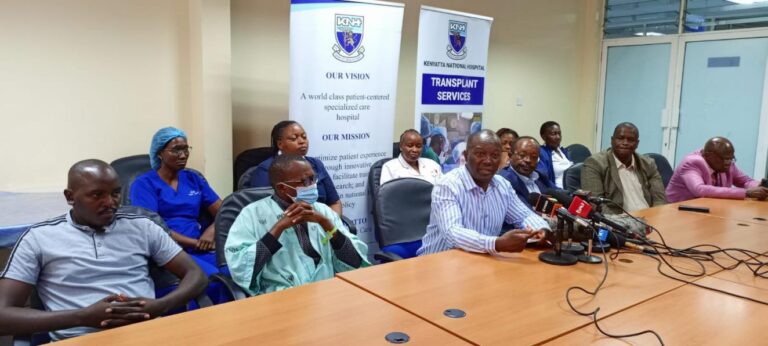
Doctors at Kenyatta National Hospital conducted the first-ever laparoscopic kidney transplant at a public hospital in Kenya.
The three-hour highly delicate minimally invasive surgery was conducted by a team of medics led by Dr. Paul Njogu and Dr Charles Waihenya, both of whom are respected urologists in the country.
The procedure was conducted on Mr. Dickson Njorogeyson, with the donor being his cousin – Mr. Dickson Ndekei Wanjiru.
“We are moving from the traditional open method to a far more advanced modern frontier,” said Dr Njogu in an interview.
“Thanks to technology we are able to use computer-guided laparoscopic instruments which make the process far safer to the donor and the recipient. The open one leaves a scar, but with this method, it is barely noticeable and therefore aesthetically appealing. It takes less time thereby reducing the turnaround time with better clinical outcomes,” he added.
Chief Executive Officer Dr. Evanson Kamuri, CBS, EBS while congratulating the team that conducted the exercise said the Hospital was working towards improving the operational efficiency of its kidney transplant program as it scales up its groundbreaking surgeries in the facility.
Dr. Kamuri said such a procedure, scientifically known as donor nephrectomy laparascopic surgeries, was possible with the availability of the hospital’s tissue typing laboratory, the only one in the region.
“Our focus now is to increase the operational efficiency of our transplant program. This includes reducing our turnaround times. The presence of our tissue typing lab is also a bonus for us. It only takes a few days to get tissue typing results at a less cost, ‘he said.
Mr. Njorogeyson, the recipient was diagnosed with chronic kidney failure last year.
“I always felt tired and worn out after work, and could not sleep well so I thought these were normal signs and symptoms of diabetes. I have been a diabetic patient since 2004,” he said.
“My eyes were yellowish, my sight was blurry which prompted me to visit Kikuyu Eye Clinic who indicated that most likely it was a renal problem; they referred me to KNH,” he added.
“Fortunately, the problem was diagnosed as kidney failure. I started dialysis sessions at the Renal Unit. The doctors advised that there were two options; dialysis and transplant. I opted for a transplant after confirming that it is successfully done in the hospital. I brought my brother and sister for donor matching and they both failed,” he said.
Mr. Njorogeyson said his cousin, Mr Ndekei on learning that his brother and sister failed the ‘donor’ tests, agreed to donate one of his kidneys.
“I was then successfully transplanted my cousin’s kidney. I thank Mr. Ndekei, the management of the hospital and all the medical personnel who were involved in the process. May God bless you all,” said Mr. Dickson Njorogeyson.
On his part, Mr. Ndekei said he did not hesitate to help his cousin when he was informed of his predicament.
“This was a personal decision that did not need the family’s intervention. I’m happy I was able to help,’ he said.
Traditionally, donor nephrectomy laparascopic surgeries required a healthy individual, the donor, to undergo a major operation where the kidney was removed through an incision in the side using a large incision.
This so-called “open” procedure was associated with significant pain and a substantial recuperation period for the donor.
In contrast, for a laparoscopic donor nephrectomy, tiny incisions are used, and the kidney is removed using a scope or camera and special miniaturized surgical instruments.
The advantage of this procedure is that it has a shorter recovery period, and the complication rate is very low. In addition, the quality and function of the transplanted kidneys are excellent.
During the procedure, the kidney is freed using 4 ports and removed through an incision in the lower abdomen. The transplant surgeon then immediately prepares the kidney and places it in the recipient.
Results (graft survival) have been comparable to kidneys removed via traditional open surgery. In addition, patients are hospitalized approximately 3 days shorter and return to normal activity almost 3 weeks earlier.
